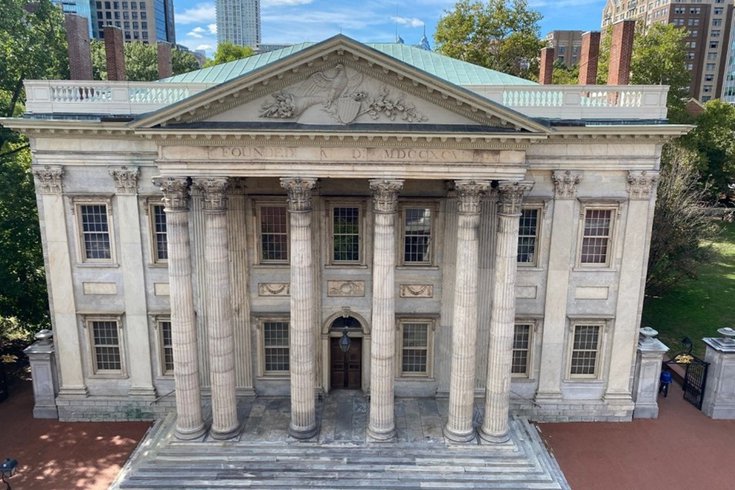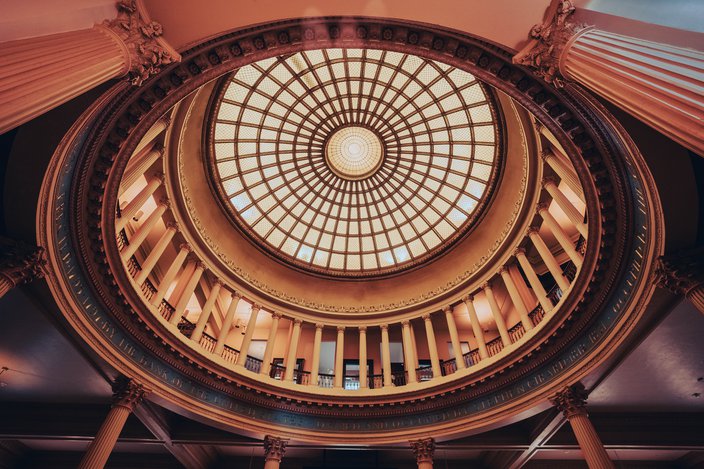
July 10, 2023
 Provided Image/Independence National Historical Trust
Provided Image/Independence National Historical Trust
The First Bank of the United States, at 120 S. Third St., will be turned into a new museum exploring the nation's economic history. The building has been closed to the public for more than 50 years.
Federal funding has been secured to transform the First Bank of the United States building in Old City into a museum that will feature exhibits about the nation's economic history.
The First Bank building, at 120 S. Third St., has been closed to the public for decades. Its Corinthian marble columns have made it a popular place to take photos, but its role as the oldest surviving federal building has not been well-explained to visitors of Independence National Historical Park.
"The restoration of the renowned building gives the park the opportunity to showcase aspects of the economy of the early republic and the role of the controversial national bank," INHP acting Superintendent Amnesty Kochanowski said, adding it has long been a goal to bring the property back into public use.
In the years after the Revolutionary War, the Founding Fathers were bitterly divided over the Constitutional grounds for establishing a national bank. Alexander Hamilton, secretary of the treasury under President George Washington, advocated creating a bank in Philadelphia to unify the national economy. It would pay off the states' respective war debts, collect federal taxes and create a common currency.
Thomas Jefferson, Washington's secretary of state, fiercely opposed the national bank. He feared it would undermine the banks established in the states, creating a financial monopoly that favored merchants and financiers over debtors such as plantation owners and farmers. Jefferson and James Madison, both instrumental in framing the Constitution, believed a national bank violated both the spirit and letter of the law because it did not fall under the document's "enumerated powers."
Hamilton shrewdly interpreted the bank's legality as part of the "necessary and proper" clause of Article 1 of the Constitution, setting a precedent for broader expansion of federal power in the years to come.
Washington, although skeptical, signed the so-called "bank bill" into law in 1791 after its passage by Congress. Along with the creation of a federal mint and the establishment of excise taxes, the national bank was given a 20-year charter that allowed it to establish branches in other states. The main branch in Philadelphia was built between 1795 and 1797, about 1,000 feet from Independence Hall, and is regarded as one of the most important artifacts of the Washington administration.
Plans to turn the building into a museum have been in the works since 2017, when the Independence Historical Trust began raising private funds for the project. A new $22.2 million construction grant has been awarded from the Legacy Restoration Fund of the Great American Outdoors Act, which was passed by the Trump administration in 2020 to invest in park maintenance. An additional $6.6 million is needed to create a series of educational exhibits that will examine the history of money, land, work, trade and the role slaves played as collateral in the national bank's southern branches.
Exterior work on the building will include replacement of leaking metal roofing and other weathered design elements, as well as the cleaning and repair of marble and brick masonry. The pediment above the marble columns includes the first-known depiction of an American eagle with 13 arrows in its talons, signifying the 13 states that formed the new nation.
Inside, the work will include updating electrical and HVAC systems, replacing an elevator and adding accessible restrooms and a fire suppression system. The building's grand interior, featuring a floor to ceiling rotunda supported by 42 columns, will be retouched to preserve renovations made in 1902.
The dome of the First Bank of the United States.
The federal funds also will support an addition behind the bank that will serve as the museum's main entrance. The front entrance will continue to be used for special events.
West Chester-based contractor the Bedwell Company has been selected to complete the renovations.
The early role of the national bank was a far cry from today's modern central bank. It was a private corporation with public duties, but unlike today's Federal Reserve system, the First Bank still served as a commercial bank for the American people. The Fed, established in 1913, acts as a bank for commercial banks. It sets monetary policy, regulates private banks, holds excess reserves and operates as a lender of last resort, none of which was done by the First Bank of the United States.
When the First Bank's charter expired in 1811, President Madison chartered the Second Bank of the United States, at 420 Chestnut St., in Philadelphia despite the U.S. Capitol having moved to Washington at the turn of the 19th century. That building, architecturally similar to the First Bank, now houses a portrait gallery of prominent early Americans.
The First Bank went on to be purchased by Stephen Girard, who operated the building privately and served as the nation's largest creditor during the War of 1812. The business was later chartered by Philadelphia merchants and operated for decades until the passage of the National Banking Act at the end of the Civil War, when it was reorganized as Girard National Bank and had no remaining ties to Girard. The bank later moved to the newly constructed Girard Trust Building on South Broad Street, which today houses the Ritz-Carlton Philadelphia hotel. Girard National Bank went on to be acquired by Mellon Bank in 1983, and later Citizens Bank.
The First Bank building on Third Street most recently was used as an administrative office for the National Park Service. It was acquired by INHP in 1956.
The renovations are part of a broader planning effort around Philadelphia's upcoming semi quincentennial celebration in 2026. The Independence Historical Trust anticipates construction work related to the museum will be finished in 2025.
 Provided Image/INHS
Provided Image/INHS